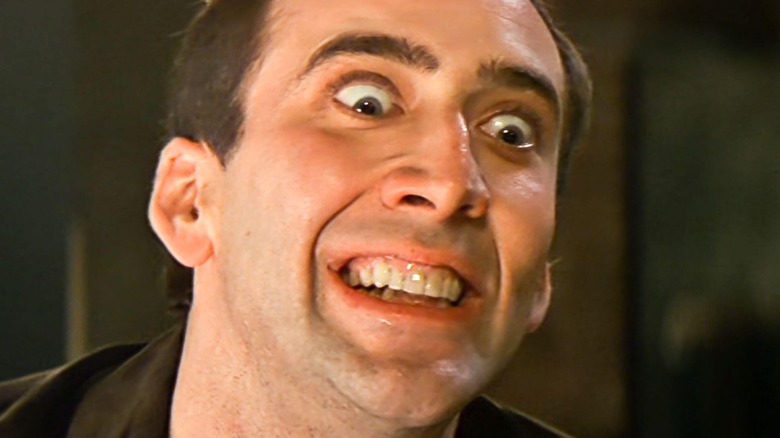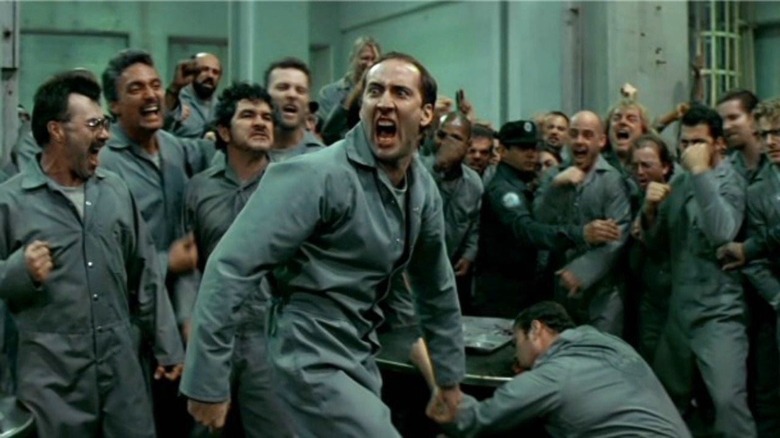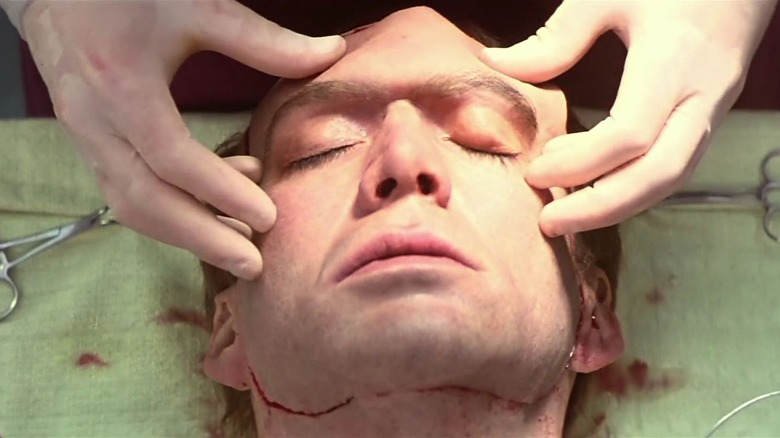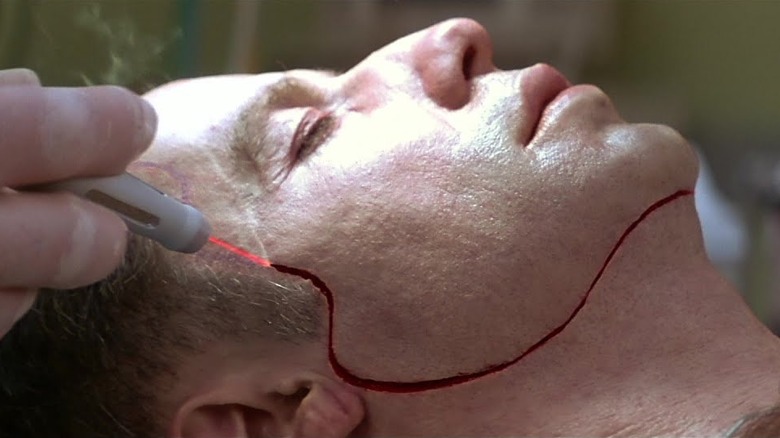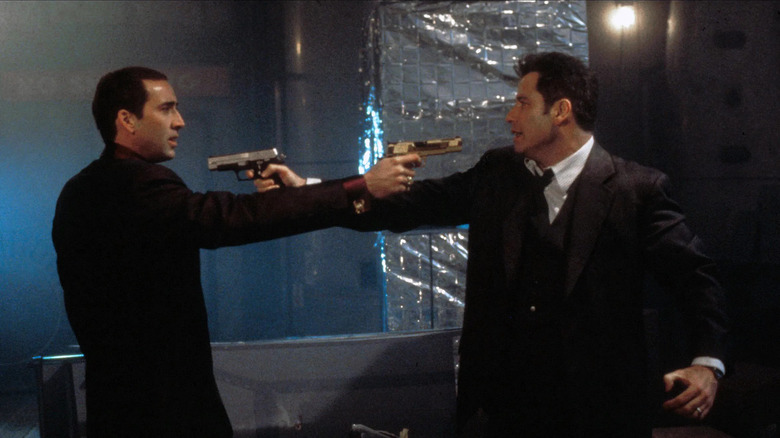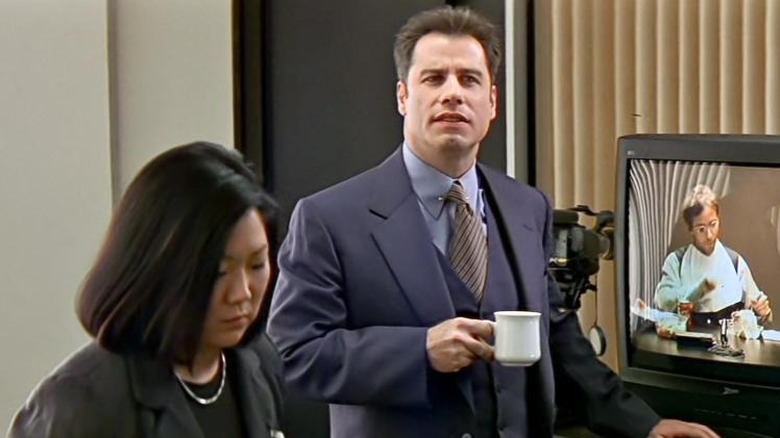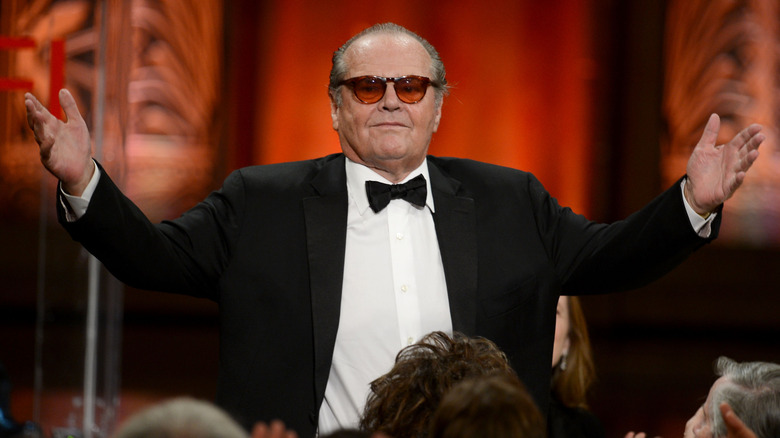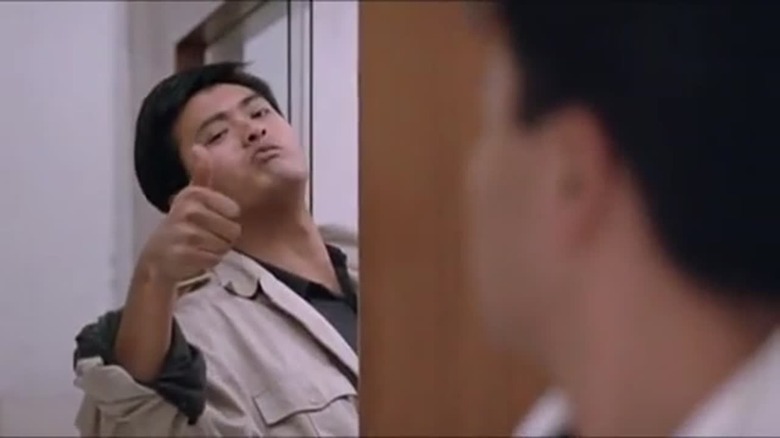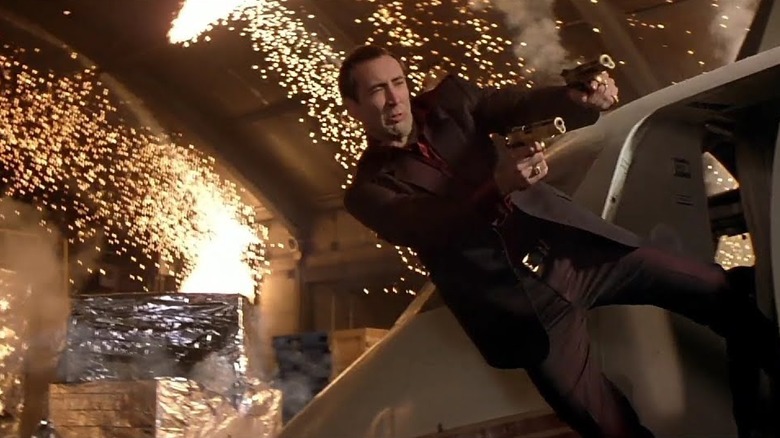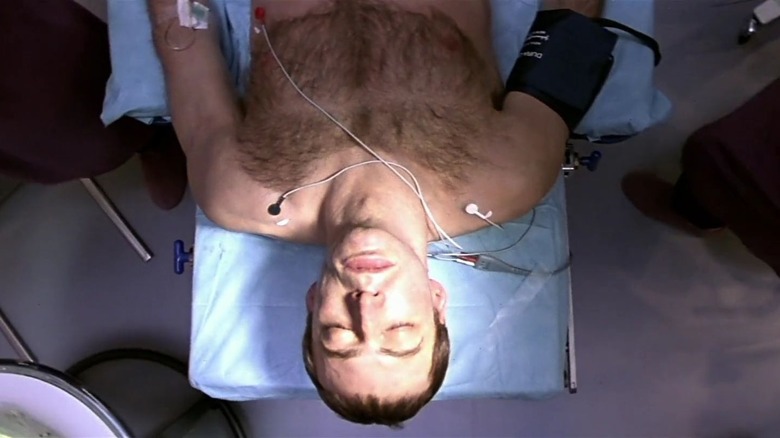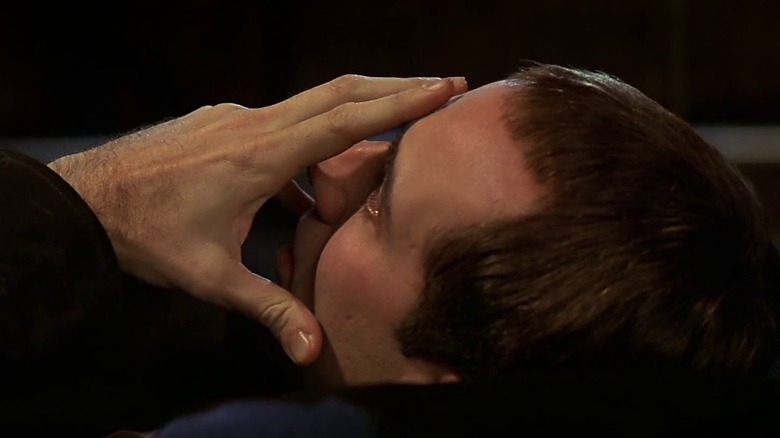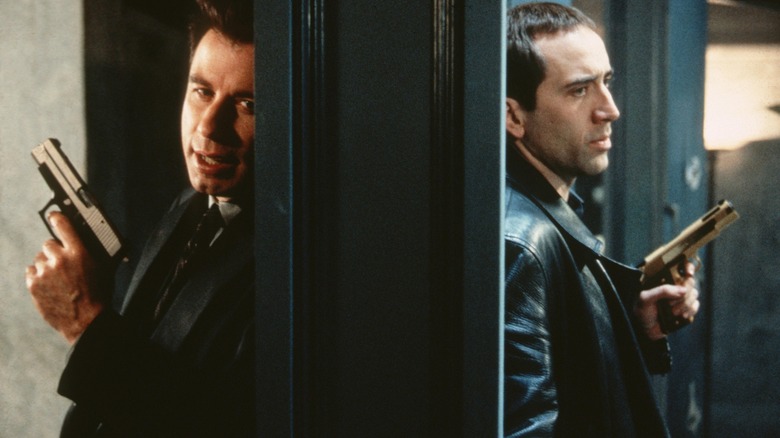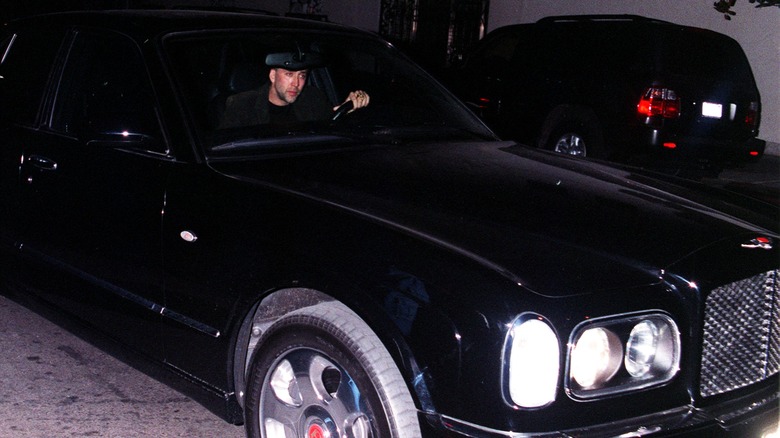The Untold Truth Of Face/Off
"Face/Off" is a truly unique creature in the world of Hollywood action filmmaking. Where else can you find legendary Hong Kong director John Woo and stars Nicolas Cage and John Travolta combining their own distinctive brands of excess in one movie? Combine that with the totally ludicrous face-swapping conceit that gets it all going, and it's no wonder the Washington Post called it "one of the strangest stories to ever get the green light at a Hollywood studio."
All the plot machinations that lead up to FBI agent Sean Archer (Travolta) switching places with his son-murdering nemesis Castor Troy (Cage) fall apart under any explanation other than "so the story can keep going." But who cares when keeping the story going means we get Nicolas Cage posing as a headbanging priest and crashing a jet into an aircraft hangar in a rain of sparks just to start with. It all builds up to an extended climax that takes the hero-villain pair from a church to the ocean to Cage launching a speedboat off a yacht, which, of course, blows up behind him.
Even if it were just that level of silliness, its legacy would be assured, but Cage reminds us all why he won an Oscar the year before with his deeply felt performance as a grieving father trapped in the body of his son's killer.
Nothing this spectacularly bonkers could be pulled together without a lot of shenanigans behind the scenes, and some of these stories are wild enough to be worthy of "Face/Off" itself. Take a look.
The whole story grew out of the prison sequence
In order to disarm the dirty bomb Castor Troy has left in an undisclosed location, Archer has to take his place in prison so he can pump Castor's brother Pollux for information. As if the mythological reference wasn't literary enough, the prison itself is named after Samuel Butler's anagrammatic utopian satire "Erewhon." It's a fitting name since, as Archer discovers the hard way, it really is in the middle of nowhere, on a repurposed oil rig in the open ocean.
There's so much wackiness going on in "Face/Off" that the prison break, forced on Archer when he discovers Castor has stolen his face and destroyed all evidence that he was undercover in prison, seems almost tame. But without that sequence, the rest of the movie might not exist. First-time screenwriters Mike Werb and Michael Colleary told Inverse that the 1971 Attica Riot and the Jimmy Cagney classic "White Heat" inspired them to start their careers with a prison movie. From there, they came up with the idea of a futuristic prison where guards could put down a riot by flipping a switch to lock down the inmates' magnetic boots.
Then they came up with the idea of a hero taking the villain's place in prison, but they wanted to avoid things that had already been done, like identical twins, swapping personalities, or even magic. Whatever else you can say about the face-trading story they came up with, it certainly hadn't been done before.
The title came from a traumatic childhood misunderstanding
Writers usually get sick to death of everyone asking where they get their ideas. But when the idea is "Face/Off," it's hard to resist, especially with the knowledge that it was their solution to the simple problem of getting their hero into prison. Mike Werb clarified that question to Inverse, reaching back into his childhood memories of his Aunt Sunny saying she was going to "take her face off." To an adult, that's a pretty simple way to say she was cleaning off her makeup. But "to a 7-year-old, it was terrifying."
It was terrifying enough to haunt him decades later and provide the idea for the facial surgery plotline and the title for the whole project. We have to wonder if little Michael would take some comfort in knowing his misplaced terror would someday make him millions of dollars. Who knows? Maybe he decided to spin an original story out of it because he knew the Beatles would never sell him the rights to turn "Eleanor Rigby" into a horror movie about a monster "wearing the face that she keeps in a jar by the door."
The first draft was an even wilder science fiction story
Other than Erewhon and the face-swapping technology, "Face/Off" goes light on the sci-fi elements. It works — we all suspect the secretive upper echelons of the government have access to technology we civilians can only dream of, or else where would James Bond and all his gadgets be? Besides, all the physics-defying stunts and stylized acting make it clear we're nowhere near the real world to begin with.
Despite all that, Werb and Colleary's original vision for "Face/Off" would have applied the surgery's level of futuristic fantasy to the whole movie. ShortList's "deep dive" into the movie's production reveals that the first script took place 100 years in the future and included a workforce of trained chimps, the Golden Gate Bridge turning into a homeless encampment, and, of course, flying cars. The prison would have been even more outlandish, with the home video audio commentary revealing an early script had the prisoners magnetically chained to the ceiling instead of the floor.
But all that world-of-tomorrow business costs money, and the producers talked Werb and Colleary out of it. One of them, Barrie Osborne, told Inverse, "That allowed me to cut $20 million out of the budget right away." A little nip and tuck to the script to make the face/off operation a cutting-edge experimental procedure, and it was ready to go, with the added benefit of upping the tension of Archer having to convince people of his unbelievable, now unprecedented story.
The producers had some even weirder ideas about Face/Off
John Woo's commentary includes him gushing about how much creative freedom he had on "Face/Off," but before he came on board, the script got some notes from producers that make you wonder how they ever got to be producers to begin with. Michael Colleary told Inverse that they lost a deal at Warner Brothers in part because the higher-ups kept fretting about whether prosthetic makeup technology was advanced enough for the two leads to play each other. Mike Werb added, "Both of us were going, 'Did you read the script? It's the same actor!'"
Even when the script found a home at Paramount, the notes didn't get any more helpful. Colleary told ShortList that the producers kept insisting that Castor Troy's smart bomb should somehow become so smart that it gained consciousness. Fortunately, the writers knew that was too silly even for "Face/Off," moved the notes to the ol' round file, and stuck to their guns until they could get a collaborator who understood their story.
John Woo's daughter convinced him to cast Margaret Cho
All kinds of surreal things happen in "Face/Off," but we can't let that distract us from some of its more understatedly bizarre elements. For instance, there's beloved stand-up comedian and "Fire Island" star Margaret Cho in a joke-free bit part as an FBI agent.
How does anyone reach a casting decision like that? Well, John Woo was just listening to what the youth of the nation wanted — or at least one youth. The director explains in his commentary that Cho had been lobbying for the role, but that what finally won him over was his daughter Kimberly, a huge Cho fan. In the end, Woo acquiesced, because in his words, "I have to try to make my daughter happy." But since it was such a small part, Woo unfortunately didn't get to spend much time with his daughter's idol. Hopefully Kimberly was able to forgive him.
As for Cho, she remembers filming "Face/Off" as a thrilling but unnerving experience. How do you transition from telling jokes onstage to playing a hard-nosed FBI agent? She told Collider that the answer involved "a lot of going to training camps where you would learn how to properly shoot a gun, properly look like you were in the FBI ... You also had a stunt double that was pretty much the physical perfection version of yourself, which is really strange."
The writers wanted Jack Nicholson to play Castor's mother
How could you make "Face/Off" even more over-the-top bizarre? How about casting Jack Nicholson in drag as Castor Troy's mother? Well, that's exactly what Werb and Colleary reveal they wanted to do on the commentary track. At one point in development, instead of hiding out with Castor's criminal accomplices, Archer would have found refuge in his enemy's childhood home and come away from the experience with new sympathy for the man he's sworn to bring to justice.
Werb and Colleary hoped for "somebody really out there" to play the Troy family's eccentric matriarch — along with Nicholson, they considered '60s Hollywood royalty, "Who's Afraid of Virginia Woolf" star, and camp icon Elizabeth Taylor. "Total stunt casting," in the writers' own words.
Sadly, they opted to take the plot in a different direction, so we may never see what either actor would look like in full Mama Troy getup. That's too bad, because all work and no playing old ladies makes Jack a dull boy.
The writers kept begging John Woo to find a role for Chow Yun-fat
Long before he came to Hollywood, John Woo was already a legend in his native Hong Kong. His graceful, heavily stylized approach to action became its own subgenre, variously known as "blood opera," "bullet ballet," "gun fu," or "heroic bloodshed." Star Chow Yun-fat was right there beside him for most of his biggest hits, bringing Woo's repressed but deeply emotional heroes to life in classics like "The Killer" and "A Better Tomorrow" before reaching even greater levels of fame in the international blockbuster "Crouching Tiger, Hidden Dragon."
Working with Woo was a dream come true for Werb and Colleary, and they say on the home video commentary that writing a perfect John Woo movie without realizing it was a highlight of their careers. Their enthusiasm for working with their hero lasted all through the shoot, and they gush about how exciting it was to collaborate with Woo on one of his trademark church shootouts, doves flying and all. They also remind Woo how hard they pushed to make the movie even Woo-ier: "Your fans might also be interested to know how many times we tried to talk you into finding a part for Chow Yun-fat." Unfortunately, they never did — Yun-fat would have to wait until the year after "Face/Off" premiered for his first Hollywood role in "The Replacement Killers."
The writers tried 10 different ways to get Castor into a coma
"Face/Off" has no story if Sean Archer can't take Castor Troy's face off, and before that can happen, Castor has to go into a coma, or else he'd never part with his beautiful Nicolas Cage face. With all the chaos in the runway shootout, you wouldn't think that would be so hard to do, but Werb and Colleary had a heck of a time of it.
On the commentary, Werb tells John Woo, "One of the things, John, that we remember from this sequence was how many times we tried to get Nic Cage in a coma. We wrote like 10 different versions for you, and it was like, no, it's not good enough, it's not good enough, it's not right." While he doesn't run through all 10 alternatives, Werb does mention a few: falling off an air traffic control tower, which Woo nixed for breaking too many bones, or getting cryogenically frozen when he blows up a storage tank. Finally, Werb and Colleary hit on a solution that met Woo's approval. But then, who wouldn't approve of a stunt as awesome as using a jet engine like a giant cannon?
The Nicolas Cage animatronic was so good it fooled the writer
Since John Woo and crew couldn't actually flay the faces off two of Hollywood's biggest stars, the surgery scene required dummy stand-ins instead. The effects team went all-out: Art director Steve Arnold told Inverse that he found the complex animatronics both "amazing" and "scary": "You could see the blood veins, you could see it pulsating, you could see those little hairs. It was so impeccably done that Travolta was kind of freaked out."
In a promotional video, effects artist Kevin Yagher describes how painstakingly he approached the process, matching the fake Cage and Travolta to the genuine models "perfectly in every way, down to the pore," while the narrator adds that "hundreds of thousands of individual hairs were applied to the skin, one at a time." Cage was just as freaked out as his costar: "You could trip out on it," he says. "It breathes, and it twitches its face, it's amazing."
Mike Werb handled seeing the figure much more evenly, mostly because it took him a long time to realize it wasn't really Nicolas Cage lying there. Walking onto the set in the dark, he assumed the dummy was the real Cage, either sleeping or meditating: "Little did I know Kevin Yagher and his guys were using the air bladders and [screwing] with me."
Cage and Cassavettes kept going after Woo yelled cut
Of all the gleefully absurdist moments in "Face/Off," a standout has to be a conversation between Archer-as-Troy and Nick Cassavettes as the real Troy's accomplice, Dietrich. Archer/Troy fantasizes about finally catching up with Troy/Archer and switching their faces back. It quickly descends into "Who's on first" territory: "I'd like to take his, his face...off."..."Cas? You wanna take his face..." "Yes. His face off. Eyes, nose, skin...it's coming off." "His face...off."
It shouldn't surprise Cage fans to learn that scene was all him. And it shouldn't surprise at least some of you that he took it much, much farther than what made it to the screen. John Woo recalls in his commentary that by this point in the shoot, everyone was drunk and tired, making the Nicks just loopy enough to go off script and riff endlessly on the movie's title. Woo actually yelled "Cut!" in the middle of the scene when Cage excuses himself to "the little boys' wee-wee room," but the cameras kept rolling anyway. Werb adds that Cassavettes and Cage kept right on riffing for five minutes before the scene was cut down to a more manageable size in the editing room.
John Woo paid out of pocket to get the mirror scene in the movie
If there's one word to describe the basic theme of "Face/Off" — other than "bat****" — it's "duality." Sean Archer and Castor Troy are perfect mirror images: the uptight lawman who refuses a celebratory bottle of champagne until he can use it as a tribute to his fallen comrades, and the horrifically uninhibited criminal who shrugs after he snaps a woman's neck and is greeted everywhere he goes by a lackey with a briefcase full of contraband.
It was important for Woo and his collaborators to visually emphasize that duality, and Colleary and Werb remember in the commentary how the script originally included a shootout in a mirror factory. That eventually evolved into what Werb calls "the grandest dressing room of all time," but even that was too expensive for the studio, which was concerned that the film was running over budget. So John Woo says he told the studio, "I'm willing to pay with my own money to shoot the scene. Just give me two days ... I've got to shoot it. I've got to have it." The studio may have objected to the scene at first, but they obviously came around, since that scene ended up all over the marketing.
Nicolas Cage had luxury cars delivered to the set
Castor Troy may be pure evil, but at least he knows how to enjoy the finer things in life — fast cars, loud suits, and golden guns. Then again, he also calls Handel a hack, so maybe it's more appropriate to say he enjoys the expensive things in life. Either way, that gives him plenty in common with the real Nicolas Cage, a man whose Batman-villain-worthy collection of fossils, castles, shrunken heads, and private islands (via CNBC) forced him into his current anything-for-a-paycheck lifestyle when the taxes came due.
So you can imagine how much Cage enjoyed himself at the height of his fame in the late '90s — like a kid at the Toys R Us Super Toy Run. Barrie Osborne told Inverse how his star's expensive habits occasionally intruded on production: "A car delivery service would show up with a really hot new car for Nic," he recalled. "I think they were Lamborghinis. There were at least two or three delivered." Hopefully at least one of those castles had a roomy garage.
